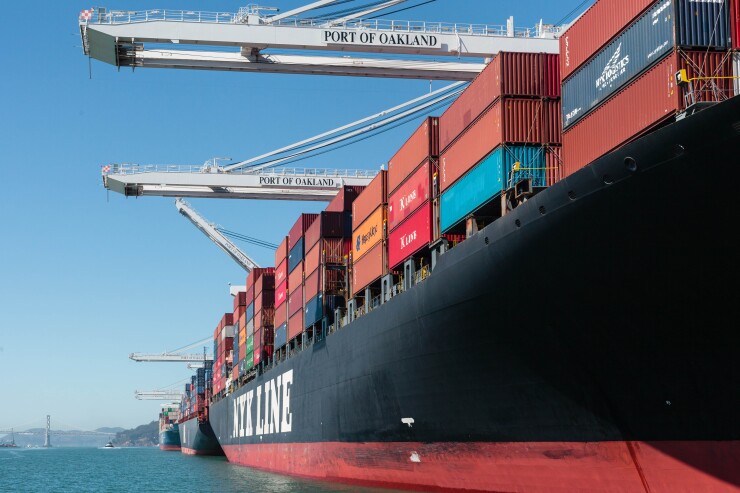WASHINGTON -- Revenue growth is still healthy in the transportation sector among ports, airports and toll roads, but tariffs and the recent Boeing 737 MAX 8 grounding could hinder that growth the rest of this year.
According to a Fitch Ratings report published Monday, analysts found airplane passenger traffic was still healthy with three quarters of airports seeing 3% growth or higher last year. U.S. passenger enplanements grew 4.8% in 2018, an increase of 1.3% from 2017.
However, recent groundings of Boeing 737 MAX 8 could pinch the growth of some airports, said Seth Lehman, a Fitch analyst. The fleet was grounded after two international crashes involving the aircraft occurred in a span of about six months. Lehman said the grounding could last until the peak of the summer months.
“There’s very little data to say how much air traffic has been affected to date because it’s a very small part of the fleet for the major airlines in the U.S., only 2-3%,” Lehman said. “Some of the airlines have said that they’ve been able to rebook passengers onto different flights.”
Other airport trends include more spending for capital projects, Lehman said. He also noted that the rating agency recently upgraded Southwest Airlines to an A-minus, an uptick among airlines as a whole.
“Airline credit quality continues to show improvement, which is a positive signal for the aviation industry, including airports,” Lehman said.
On the port side, Fitch analysts saw an increase in port volume and cargo growth in 2018 because shippers wanted to move cargo ahead of tariff-related deadlines.
“Overall I think we saw both East Coast and West Coast at the end of the year, the volume went up a bit and a lot of it is because of that front-loading of any cargo that would be subject to the tariffs,” said Emma Griffith, Fitch analyst.

The U.S. and China have been in a trade war since 2018 with both sides imposing tariffs on the other. Though the effects of the tariffs won’t be seen in the next year, they could be more impactful long term, Griffith said.
“Longer term if this turmoil continues, you’ll start seeing longer term changes like movement of production to other countries or diversification of some of the production locations to southeast Asia or other countries that would be lower cost,” Griffith said. “That’s not something that happens in one year.”
In the long term, ports may experience more volatility if they have a higher concentration with Chinese trading partners, Griffith said.
Moody’s analysts wrote in their December outlook that the impact of higher tariffs will intensify in 2019.
The American Association of Port Authorities will continue to monitor the impact of tariffs said, Mary Beth Long, AAPA vice president of external affairs. Difficulties with a tariff or relationships with other countries affects ports’ growth, she said.
“We’re monitoring it and we’re trying to make sure that it doesn’t impact them, but it could,” Long said.
Fitch also analyzed toll road trends and said 2018 was “a mixed bag for toll roads.” The sector experienced 3.9% revenue growth in the third quarter of 2018 but that fell to 1.6% in the fourth quarter, in line with a slowing U.S. economy, according to the report.
For 2019, Fitch expects rising inflation and slower, but still solid GDP growth to increase traffic and toll rates, translating to higher revenues, Scott Monroe, Fitch analyst, wrote in the report.
“In some regions, like the Southeast and the Southwest, there’s especially strong demographic trends in terms of population growth and employment,” Monroe said. “In some regions you could see that level of growth kind of exasperated especially in comparison to the Midwest and some portions of the Northeast."
Monroe also expects higher inflation at 2.2% in 2019, up from 1.9% in 2018.
“A lot of times public tolling entities and even some private ones will link their toll rates to inflation so to the extent that inflation goes up, you also see those toll rates to go up, which will cause revenues to rise,” he said.
Fitch expects GDP to grow 2.3% in 2019 and so should accommodate continued traffic and revenue growth in 2018, according to the report.
In a U.S. transportation infrastructure 2019 outlook, S&P Global Ratings predicted toll roads’ revenue to grow.
“Trends remain positive for the toll road sector, because we anticipate slower traffic and toll revenue growth will outperform base-case GDP as open-road tolling expands,” according to the report.
The International Bridge, Tunnel and Turnpike Association also saw growth in its data, said Patrick Jones, IBTTA executive editor and CEO. As traffic increases, there is more interest in public-private partnerships, but Jones said “it’s not a magic bullet.”
“It’s one of the ways in which to deliver mobility or to deliver a new transportation facility or infrastructure,” Jones said.





